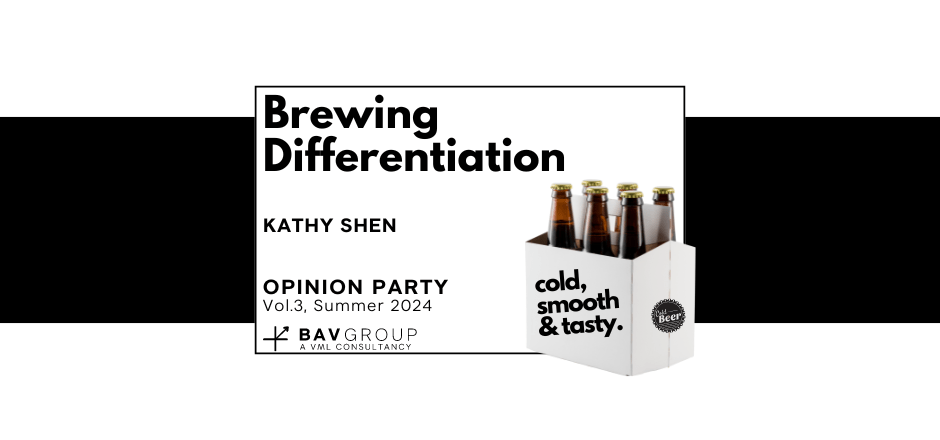Brewing Differentiation
08.22.2024

As the warm embrace of summer approaches, many of us look forward to the simple pleasure of a cold beer in hand. Whether it's a backyard barbecue, a beachside picnic, or or a baseball game, beer often plays a starring role in our favorite summer occasions. However, despite its ubiquity and popularity, the traditional beer category faces unique challenges in the marketplace.
In the BrandAsset Valuator® (BAV) syndicated study, the beer category is largely unchanged over the past decade. Despite a high level of familiarity with classic beer brands, consumers appear to find little differentiation among them, resulting in lower brand loyalty than you might expect, and competition primarily based on price.
The lack of differentiation is particularly stark when compared to other alcohol categories such as liquor and wine. The traditional beer category is infamous for its commodification and has a 51% higher churn rate than wines as well as a 37% higher churn rate than ciders, hard sodas and hard seltzers, according to BAV data. This indicates a unique challenge for beer brands: maintaining consumer commitment and reducing attrition
Our also data indicates that the traditional beer category struggles with an average perceptual overlap as high as 91%. Essentially, all brands are perceived as simple, social, traditional, and good value.
To differentiate themselves, the large beer companies rely heavily on sponsorship and strategic partnerships, such as Budweiser's partnership with Major League Baseball (MLB), Corona's association with Coachella, and Miller Lite's deal with NASCAR. These collaborations help cut through the clutter, adding a unique twist to the beer category that's often seen as too similar.
However, not all collaborations yield positive results. A recent example is Bud Light's collaboration with Dylan Mulvaney, which faced high-profile problems and backlash. Such instances serve as reminders that while partnerships can bring uniqueness, they must be carefully considered and strategically implemented.
As we raise our glasses to toast the summer, it's worth keeping an eye out for new and unexpected collaborations. These partnerships could potentially redefine how we perceive and engage with our favorite beer brands, for better or worse.
Data Source: BAV Syndicated USA Q2'2023-Q1'2024
Want to better understand which partnerships might help your brand stand out?
Contact us to schedule a 30 minute complimentary consultation.
Author: Kathy Shen
Manager, Strategy & Insights
Prior to joining BAV Group, Kathy attended Northwestern University, where she graduated with a MS degree in Integrated Marketing Communications and specialized in brand strategy and consumer insight analysis. During her studies, Kathy also worked as a student consultant for Walgreens, leading a project to map out growth strategies for the company to increase brand love and loyalty during the pandemic. Kathy has recently become a cat mom and has been spending most of her free time playing with her two ragdoll babies while trying to lower her previously high personal hygiene standards.
Connect with Kathy on LinkedIn
Opinion Party (Vol 3): Summer Beach Reads
This article is from the third volume of "Opinion Party" from BAV Group, a collection of points of view that focused on embracing the unknown, trusting ourselves and others, and ultimately a body of work that helps us all to connect around topics that unite us rather than divide us. Explore this, and the rest of the articles, to see how our authors have taken their unique experiences and written informative and timely pieces on the intersection of brands and belonging in today’s culture.
